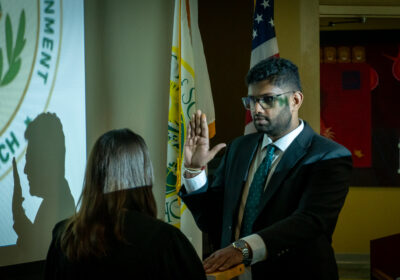Small hope found on bottom of ocean floor

The emerald sea slug absorbs DNA from algae it eats, allowing it photosynthesize. SPECIAL TO THE ORACLE
Those with color blindness, sickle cell anemia or Down syndrome must live their entire lives with their affliction encoded in their genes. But that fate may change, thanks to a green slug in Massachusetts shaped like a leaf.
USF researchers found first-of-its-kind evidence on the transfer of genes between sea slugs and algae, which could lead to improved gene therapy for people who suffer from genetic diseases.
The two-year long study, released in December, found microscopic evidence that genes were once transferred between the emerald sea slug and the algae it eats.
The slug, native to Massachusetts, caught researchers’ attention when they saw it was green and had chloroplasts, cells typically found in plants to create food through photosynthesis.
The chloroplasts can keep working through the slug’s nine- to 10-month life, according to Sidney Pierce, a USF professor and co-author of the study.
“So if you shine a light on the sea slug, it photosynthesizes just like a plant,” Pierce said. “Makes oxygen, fixes carbon. Animals can’t do that, but here’s a slug that does it.”
The emerald sea slug gets its chloroplasts from the algae it eats, sucking them up and storing them in special cells.
“I would say you have to think about it like your car,” former USF graduate student and study co-author Julie Schwartz said. “Your car’s going to keep driving as long as you have enough oil, enough gas, enough whatever it needs, but once it runs out, your car’s not going to run anymore.”
Chloroplasts need proteins created from the algae’s DNA. The chloroplasts are the only part of the algae kept by the slug.
“There’s a maintenance mechanism inside the slug’s cell to take care of those chloroplasts, and animals don’t have the genes for that mechanism,” Pierce said. “So you have to ask: well where did that mechanism come from?”
The transfer of genes between multicellular organisms had never been found, according to Pierce. Finding out how it is done, he said, could lead to treating genetic diseases in humans.
“If we can find out how they were transferred, the mechanism’s transfer, you can go and start doing gene therapy,” Schwartz said. “There’s so many genetic diseases out there where … you have a gene that’s abnormal. So you can go and put a normal … functional copy.”
Previous studies over the past decade found biochemical evidence that a transfer had occurred between the slugs and the algae, likely thousands of years ago. However, Pierce said these studies were criticized with the idea that the results found had come from contamination.
“Now we have to prove that it was not contamination, it’s not just some fluke,” Schwartz said.
To find the evidence necessary to back up previous studies, the researchers looked to find the algae genes on the actual slug DNA. They did this by first getting slugs in the larval stage of their life cycles and that had not come into contact with algae. The researchers then applied a marker for an algal gene to the chromosomes of the slugs, resulting in a match.
While these findings are an important step, Schwartz said there are still questions that need to be answered. While there have theories, scientists still don’t know for sure how the genes were transferred from the algae to the slug. Finding how this transfer occurred will be the next step to replacing defected genes in people.
“If an adult has, say, some defect in a gene, you can go and replace that gene,” Schwartz said. “You just have to find the mechanism.”







